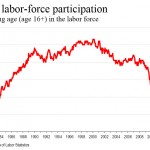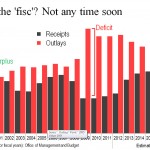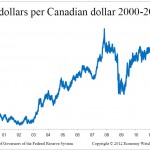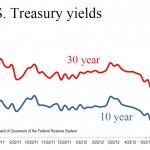My friend James McCusker, tongue planted firmly in cheek, suggests that rather than just one trillion-dollar platinum coin as a solution to our debt-deficit-fiscal mess, we mint one worth $50,000 for each of us. That’s roughly 315 million shiny tokens. Poof! Our debt problem goes away. How do you plan [continue reading . . . ]
Don’t miss today’s New York Times obit of the 1986 Nobel laureate and George Mason University professor James M. Buchanan. Like everyone else, Buchanan taught, politicians tend to act in their own self-interest Courting voters at election time, for example, legislators will approve tax cuts and spending increases for projects [continue reading . . . ]

So we have just started Year 5 of N-ZIRP, the Fed’s near-zero-interest-rate policy, and it is working so well that the Fed will have to keep printing money. What’s wrong with this picture? In fact, despite a massive expansion of the Fed’s balance sheet, and some of the lowest interest [continue reading . . . ]

Some things I hope to cover on the business-economy segment on KUOW today: U.S. economy: The Bureau of Economic Analysis announced October 26 that the U.S. economy grew at annual rate of 2.0% in the July-September quarter, much better than the 1.3% rate in the summer quarter. In real terms [continue reading . . . ]

In the decade through Fiscal 2008, Uncle Sam spent at the rate of about 19.4% of U.S. gross domestic product (GDP), and took money in at the rate of about 18.3% of GDP, resulting in annual deficits of about 1.1% of GDP. In Fiscal 1999, at the start of that [continue reading . . . ]

I’m working on charts that I will use in my upcoming speaking assignments. I try hard to make effective use of charts, especially in giving people a view from 10,000 feet, perspective aimed at overcoming the day-to-day noise about the economy. Here’s one. The seven largest advanced economies account for [continue reading . . . ]
Fix Medicare, primarily by restricting end-of-life care, as insurance companies do now. Fix Social Security by minor changes to (1) the payroll tax, (2) the benefit formula for high-income beneficiaries and (3) the retirement age. Fix the hopeless hairball that is the U.S. tax code primarily by (1) broadening the [continue reading . . . ]

That’s the headline on Page 1 of the Seattle Times today. The article reports that some residents of the Bellingham area, an easy drive from the Canadian border, are grumbling that Canadian shoppers are overcrowding the parking lots of Costco Wholesale and other box stores on the U.S. side of the [continue reading . . . ]
Back when it was published every other week, I used to treasure Fortune magazine. I looked forward to the iconic annual list of the largest companies. I loved Fortune’s deeply analytical long-form journalism on industries, companies and long-term economic trends. To cite just one example of excellence, more than any [continue reading . . . ]

Interest rates on U.S. Treasury notes with a maturity of 10 years fell last month to nearly the lowest since World War II. They may go lower still. Today’s low rates reflect both the weak outlook for most advanced economies and a desperate scramble globally for safe places to park [continue reading . . . ]
Don’t miss today’s Heard on the Street item in the Wall Street Journal headlined “Central Banks Tilt at Global Windmills.” The item, by Richard Barley, notes that “the People’s Bank of China, the European Central Bank and the National Bank of Denmark all cut rates Thursday, and the Bank of [continue reading . . . ]
Stockton’s doing it. Greece has done it. Spain and Italy are on the cusp. How do they do it? Let me count the ways. Stockton, reports the Wall Street Journal (Review & Outlook, June 27, 2012), …has a little over $300 million in general-fund backed debt, but an $800 million [continue reading . . . ]